
- Topics 1532
- Industrial 59
- Troubleshooting Guides 31
- Restaurant Management 140
- Bar Management 66
- Catering Tips 38
- Bakery Management 48
- Food Trucks & Concessions 47
- Advertising & Marketing 40
- Eco-Friendly Tips 12
- Facility Layout & Design 50
- Coffee Shop Tips 31
- Installation & Maintenance 59
- Janitorial & Pest Control 35
- Safety & Sanitation 110
- Startup Tips 113
- Menu Design 11
- Kitchen & Cooking Tips 104
- Hospitality Management 24
- Pizza & Sandwich Shop Tips 30
- Smallwares 40
- Food Prep 101
- Tabletop Items 19
- Disposables 26
- Calculators & Tools 8
- Consumables 70
- Warewashing & Laundry 21
- Cooking Equipment 101
- Food Storage & Refrigeration 54
- Beverage Equipment 39
- Office Supplies 5
While sugar is found in most plants, sugarcane and sugar beets have the most concentrated amounts of sugar, making them ideal for producing the sugar we use in food. Sugar is responsible for so much more than providing sweet flavor. It facilitates the caramelization process, balances the acidity in foods, and contributes to the appearance, flavor, and viscosity of glazes, sauces, and marinades. In baking applications, it retains moisture, prolongs freshness/shelf life, aids creaming, and imparts color and flavor to crusts. From granulated sugars to liquid sweeteners to sugar alternatives, there are so many options to choose from. We explain the benefits and applications for each choice so you can make an informed purchasing decision. Whether you're starting a bakery or stocking your restaurant storeroom, this guide will help you find the best sweeteners for your business.
Shop All Sugar
Types of Granulated Sugars
Granulated sugars are one of the most popular ways chefs sweeten foods and drinks. However, not all types of granulated sugars are the same. They vary in grain size, taste, texture, usage, and production.
White Sugar
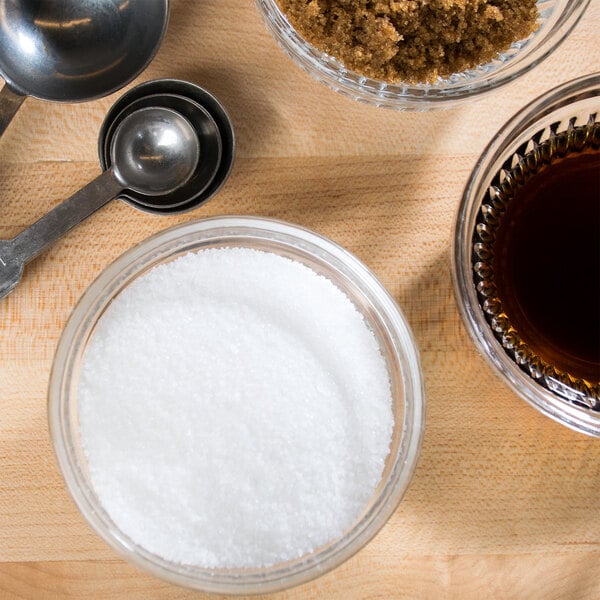
Granulated white sugar is pure, refined cane or beet juice that crystalizes and produces white sugar. It's a popular choice for commercial applications because it dissolves easily in both hot and cold liquids, making it suitable for a wide range of recipes. Granulated sugar is one of the best sweeteners for baking and is often used in beverages, sauces, and dressings to add sweetness and enhance flavor.
Granulated sugar comes in small, white granules that range in size. Common sizes include coarse (crystal/decorating), superfine (14X), cubes, and tablets. In addition to its culinary applications, granulated white sugar also plays a crucial role in food preservation. Its ability to inhibit the growth of bacteria and mold helps extend the shelf life of products such as jams, jellies, and pickles. When stored in a cool, dry place away from moisture and heat, granulated white sugar has an indefinite shelf life, making it a cost-effective option for commercial kitchens.
- Benefits: Dissolves easily, acts as a food preservative
- Applications: Baking, pastry, and sauces
Confectioners Sugar
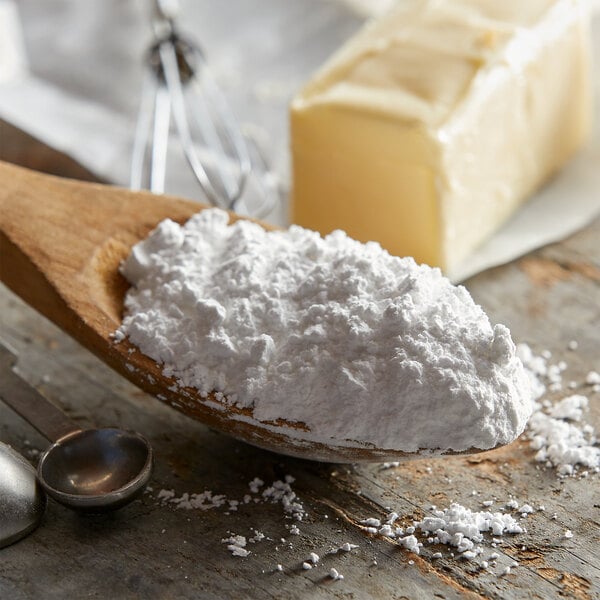
Confectioners sugar, also known as powdered sugar or icing sugar, is made by grinding granulated sugar into a fine powder and then mixing it with a small amount of cornstarch to keep it from caking. The cornstarch also helps absorb moisture. One of the key benefits of confectioners sugar is it dissolves quickly. It is often used in recipes where a smooth consistency is desired, such as frostings like buttercream, royal icing, and powdered sugar glazes.
One of the distinguishing features of confectioners sugar is its firmness, which is categorized into different levels. The firmness of powdered sugar ranges from XX to 14X, with 14X sugar being the finest variety available. The higher the number, the finer and smoother the texture of the sugar. Thanks to its powdery consistency, it's also used to dust donuts like beignets and decorate pastries like Russian tea cakes.
- Benefits: Dissolves easily, prevents caking
- Applications: Baking, icing, frostings, beverages, decorative garnishing
Brown Sugar

Brown sugar is an unrefined or partially refined soft sugar that contains molasses. This gives it a slightly moist texture and a rich, caramel-like flavor. While brown sugar was historically made by allowing some molasses to remain in the sugar during the refining process, it is now commonly produced by adding molasses back to refined white sugar. This process allows for more consistent flavor and moisture content in the final product. Molasses makes brown sugar moist, so baking with brown sugar creates both a richer flavor and a chewy texture. When added to meat rubs, brown sugar's acidity makes it an excellent meat tenderizer.
Brown sugar is available in two main varieties: light brown sugar and dark brown sugar. Light brown sugar, or golden-brown sugar, contains approximately 3.5% molasses content. It offers a subtle caramel flavor and is commonly used in baking recipes where a mild sweetness is desired. Dark brown sugar contains approximately 6.5% molasses, giving it a richer caramel flavor profile with hints of toffee. It is preferred for recipes that call for a deeper, more robust taste, such as gingerbread or barbecue sauce.
- Benefits: Moisture creates chewy texture in baked goods, adds caramel flavor, acidity tenderizes meat
- Applications: Meat rubs, BBQ sauce, gingerbread
Maple Sugar
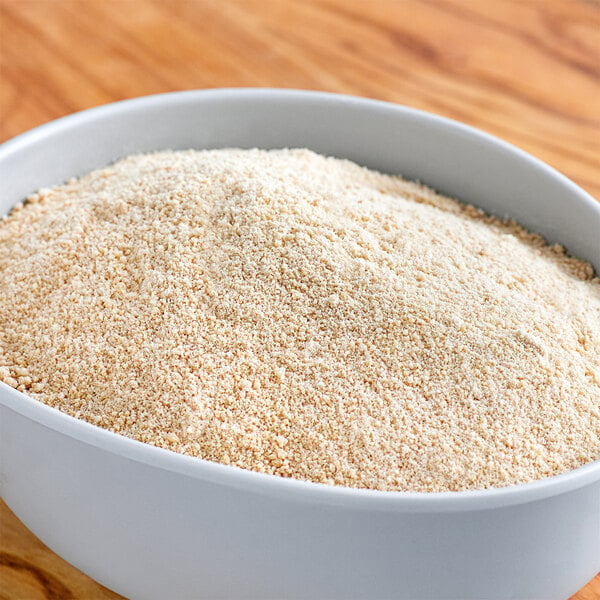
Maple sugar is a natural sweetener derived from the sap of sugar maple trees. This unique sweetener is produced through a process of boiling down maple sap until it crystallizes into granulated sugar. The natural sugars in maple sap caramelize during the boiling process, resulting in a unique blend of sweet and slightly smoky notes. This makes maple sugar a preferred choice for adding depth and complexity to a wide range of dishes, from baked goods to savory sauces.
In addition to its flavor, maple sugar also offers nutritional benefits. It contains essential minerals such as manganese, zinc, and calcium, making it a more nutrient-dense sweetener compared to refined sugars. This makes maple sugar a healthier alternative for commercial kitchens looking to enhance the nutritional value of their menu offerings. It can be used as a direct substitute for white sugar, so there is no need to reformulate a recipe. Maple sugar is available in various sizes from granules as large as table sugar to powder.
- Benefits: Contains healthy minerals, 1:1 substitute for white sugar, maple flavor, contains smoky flavors, low glycemic index
- Applications: BBQ sauce, meat rubs, coffee, baking
Palm Sugar

Palm sugar is a natural sweetener that is derived from the sap of various palm trees. The sap is boiled down to create a thick syrup, which is dried to form solid blocks or granules. This process helps retain the natural nutrients and minerals present in the sap, making palm sugar a healthier alternative to refined sugars. It has been used for centuries in many parts of the world, particularly in India, Southeast Asia, and Africa. Palm sugar is known for its unique flavor profile, which is often described as rich, caramel-like, and slightly smoky. In appearance and texture, palm sugar is dark and coarse.
Palm sugar is available in several forms, with two of the most popular being soft/spreadable and solid. Soft palm sugar is moist and resembles wet sand. This type of palm sugar is commonly used in curries, dressings, and marinades, where it can easily be mixed in to provide a subtle sweetness. It is also a favorite ingredient in desserts like puddings and custards. Solid palm sugar, on the other hand, has a harder texture and can be grated or chopped for use in recipes. This form of palm sugar is ideal for adding a touch of sweetness to baked goods, such as cookies, cakes, and muffins. It can also be dissolved in liquid to create syrups or caramel sauces. It often comes in solid blocks or cones ranging from 0.75 ounces to 9 ounces in size.
- Benefits: Unrefined and contains healthy minerals and nutrients, caramel/smokey flavor, spreadable option available
- Applications: Indian cuisine, spread for bread, Thai curry, puddings, masala chai
Raw Sugar

Raw sugar is a minimally processed sweetener that retains some of the natural molasses found in sugarcane. This type of sugar is obtained through the initial pressing and boiling of sugarcane juice, resulting in a golden-brown hue and a slightly caramelized flavor profile. Raw sugar is coarser in texture compared to refined sugars, making it a popular choice for adding a subtle crunch and depth of flavor for creating specialty desserts, sauces, and beverages that require a more complex and natural sweetness. When incorporating raw sugar into recipes, remember it has a coarser texture and slightly higher moisture content than refined sugars. This may require adjustments in mixing and baking techniques to ensure proper incorporation and consistency in the final product.
Raw sugar is available in several varieties, each with its own unique characteristics and flavor profiles. Demerara sugar is known for its coarse white sugar crystals infused with molasses syrup, giving it a slightly sticky texture and a rich, caramel-like flavor that works well in a variety of baked goods and beverages. Barbados or Muscovado sugar is another type of raw sugar that features moist, dark, and fine-textured grains. It's known for its strong molasses flavor and is often used in recipes where a deep, rich sweetness is desired. Turbinado sugar undergoes a steam-cleaning process, resulting in light brown, coarse grains. Turbinado sugar has a subtle molasses flavor and is often used as a topping for baked goods or as a sweetener in beverages like coffee and tea.
- Benefits: Unrefined, minimally processed, caramel flavor, available in several unique varieties
- Applications: Sweetening coffee or tea, baking, cinnamon sugar topping
Flavoring/Rimming Sugar
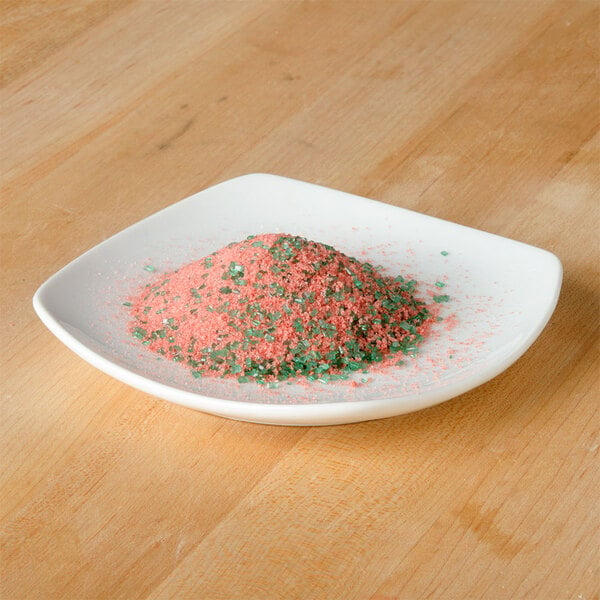
Flavored sugar, or rimming sugar, is typically granulated sugar with added flavoring. This specialty sugar is used to garnish the rims of cocktail glasses, adding both visual appeal and a hint of sweetness to drinks. Rimming sugar is available in various colors and flavors, allowing bartenders and mixologists to get creative with their presentations. It is most often used to flavor and color the rims of margarita glasses and martini glasses.
One key feature of rimming sugar is its coarse texture, which helps it stick to the glass rim. Rimming sugar is often used in combination with citrus fruits or simple syrup to help it adhere to the glass. To apply rimming sugar, the glass rim is moistened with a lime or lemon wedge, then dipped into the sugar to create a perfectly coated rim. This technique not only adds a decorative touch to the drink but also introduces a complementary flavor that enhances the cocktail's profile.
- Benefits: Makes cocktails more attractive, adds sweetness to enhance the beverage
- Applications: Garnishing the rims of margaritas, martinis, and other cocktails
Sugarcane
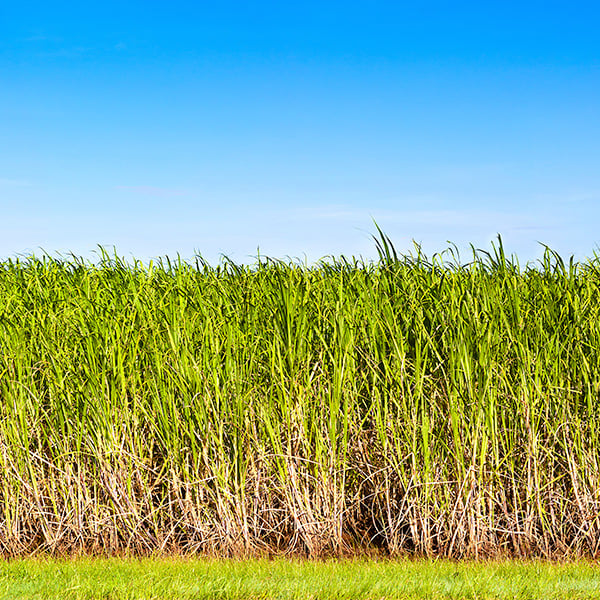
Sugar cane is a tall, perennial grass known for its high sugar content, making it a valuable source of sweeteners. Originating in tropical regions with abundant rainfall, sugar cane has been cultivated for thousands of years. It's mainly composed of sucrose, a natural form of sugar extracted through crushing and refining. The juice extracted from sugar cane is then boiled down to form raw sugar, which can be further processed into various types of sweeteners, including granulated sugar, brown sugar, and molasses.
Sugar cane juice is a popular beverage extracted from the stalks of the sugar cane plant, scientifically known as Saccharum officinarum. This juice is a sweet and refreshing drink that is enjoyed in many parts of the world, particularly in tropical regions where sugar cane is grown abundantly. To extract sugar cane juice, the stalks are crushed in a machine called a sugar cane juicer. The juicer presses the stalks to release the sweet liquid inside. The juice is then collected and can be consumed fresh or used in a variety of culinary applications.
- Benefits: Nutrient-rich, digestive health, antioxidants, hydration (if purchasing sugar cane juice)
- Applications: Made edible by boiling the stalks, snacks, garnishes, making sugar cane juice
Best Sugar Substitutes
Sugar alternatives can be a healthier way to sweeten your foods and beverages. These types of sweeteners have fewer calories and carbs than traditional sugars and can attract health-conscious consumers to your business.
Artificial Sweeteners
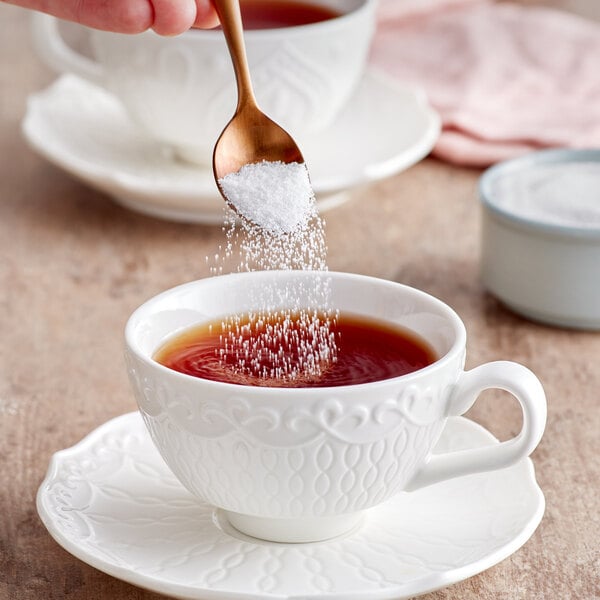
Artificial sweeteners are sugar substitutes commonly used in commercial food and beverage products to reduce calorie content and appeal to consumers looking for sugar-free options. They are many times sweeter than sugar, allowing for a lower quantity to be used to achieve the desired level of sweetness. Popular types of sugar substitutes include aspartame, acesulfame-k, saccharin, and sucralose. aspartame is one of the most widely known artificial sweeteners and is commonly found in diet sodas, sugar-free gum, and other low-calorie products. Aspartame is about 200 times sweeter than sugar and is heat-stable, making it suitable for use in a variety of food and beverage applications.
Sucralose is another popular artificial sweetener that is approximately 600 times sweeter than sugar. It is often used in baked goods, dairy products, and beverages due to its stability at high temperatures and pH levels. However, it does not provide the same structural benefits that sugar does and may require the baked good to be refrigerated. Saccharin has been in use for over a century and is about 300-400 times sweeter than sugar. It is commonly used in tabletop sweeteners and some diet foods. Acesulfame potassium (ace-k) is a high-intensity sweetener that is often used in combination with other artificial sweeteners to enhance sweetness. It is stable under heat and can be used in a wide range of commercial food and beverage products. Here are some fast facts about using each in your restaurant or bakery:
- Aspartame: Not recommended for baking applications.
- Acesulfame-K: Great sugar substitute for baking and cooking applications.
- Saccharin: Great sugar substitute for baking and cooking applications.
- Sucralose: This can be used in baking applications but does not provide the same structural benefits that sugar does and may require the baked good to be refrigerated.
Stevia
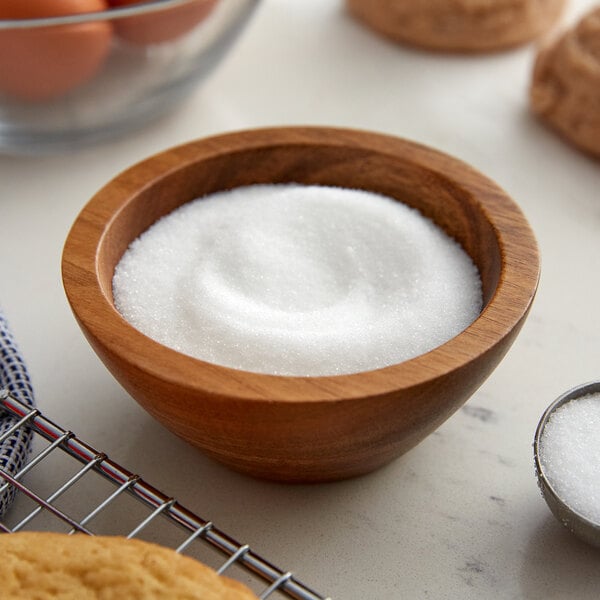
Stevia, a South American herb with a long history of use as a natural sweetener, is gaining popularity as a sugar alternative in commercial applications. One of the key advantages of stevia is its nutritional profile. Stevia has a zero glycemic index, making it a suitable option for individuals monitoring their blood sugar levels. Additionally, stevia contains zero calories and zero carbs, making it a favored choice for those looking to reduce their calorie intake without sacrificing sweetness.
In terms of sweetness, stevia is a powerhouse. It is estimated to be 25-30 times sweeter than sugar, which means that only a small amount of stevia is needed to achieve the desired level of sweetness in a recipe. This high level of sweetness makes stevia a cost-effective sugar alternative for commercial food and beverage manufacturers looking to reduce sugar content in their products while maintaining a satisfying taste profile. But can you bake and cook with stevia? The answer is yes, but there are a few things to keep in mind.
- Baking with Stevia: Since stevia is much sweeter than sugar, you only need a small amount to achieve the desired level of sweetness. It is often recommended to use a stevia baking blend, which combines stevia with other ingredients like erythritol or xylitol to achieve a more sugar-like texture in baked goods.
- Cooking with Stevia: Stevia can also be used in cooking savory dishes to add a touch of sweetness without the added calories. It can be used in marinades, sauces, dressings, and other recipes that call for a hint of sweetness. Just like in baking, remember that stevia is very potent, so a little goes a long way.
- Consider the Form of Stevia: Stevia is available in various forms, including liquid drops, powder, and granulated forms. Each form has its own strengths and weaknesses when it comes to baking and cooking. Liquid stevia drops are great for adding sweetness to beverages and recipes that require a liquid sweetener. Powdered stevia works well in baking. Granulated stevia mimics the texture of sugar.
- Experiment and Adjust: When using stevia in your recipes, it may take some trial and error to find the right balance of sweetness. Start by using a small amount and taste-testing as you go. Remember that stevia can have a slightly different taste compared to sugar, so be open to adjusting your recipes to suit your preferences.
Monk Fruit
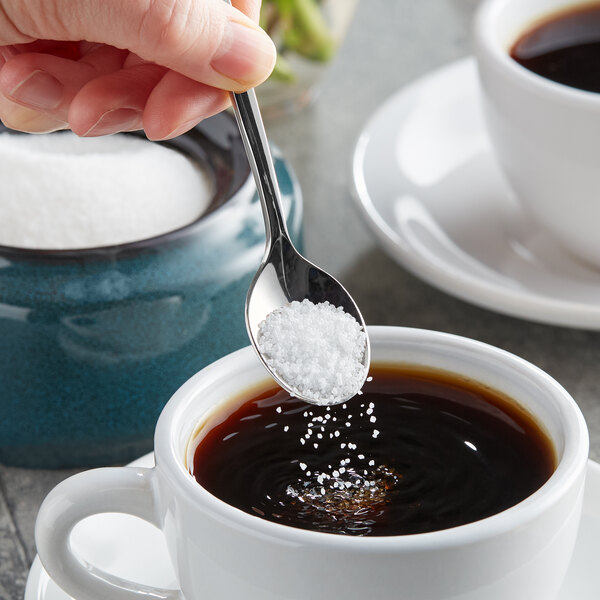
Monk fruit, also known as Luo Han Guo, is a small, sweet fruit native to Southeast Asia. It has been used for centuries in traditional Chinese medicine and cuisine for its sweetness and health benefits. The fruit gets its name from the Buddhist monks who first cultivated it in the 13th century. Monk fruit is a popular sugar alternative because it contains natural compounds called mogrosides that are much sweeter than sugar but do not raise blood sugar levels. This makes it an excellent choice for individuals looking to reduce their sugar intake.
Monk fruit is heat-stable, making it suitable for use in baking and cooking. It is important to note that monk fruit is much sweeter than sugar, so you must adjust the amount used. In cooking, monk fruit can be added directly to recipes or dissolved in liquids before incorporating into dishes. When it comes to baking, monk fruit sweetener can be used in a wide range of baked goods, including cakes, cookies, and muffins. When using monk fruit sweetener in baking, you must consider the texture and structure of the final product, as sugar plays a role in the structure and browning of baked goods. Here are some tips for cooking and baking with monk fruit:
- Avoid Crystallization: Dissolve monk fruit in the wet ingredients to avoid crystallization.
- Substitute Ratios: Many monk fruit granulated blends can be substituted for sugar at a 1:1 or 2:1 ratio. Follow the instructions of the brand, but a good general tip to avoid grainy textures is to start with a 2:1 ratio and adjust as desired for sweetness.
- Match Your Recipe: Monk fruit is made into standard dry granulated blends, powdered form, syrups, and blends that duplicate the flavor and texture of brown sugar. Find the version that most closely resembles what your recipe calls for if you're making a substitution. For example, if the recipe calls for maple syrup, opt for monk fruit syrup.
- Dressings and Sauces: To add sweetness to salad dressings or pasta sauces, opt for either liquid or powdered monk fruit.
Erythritol
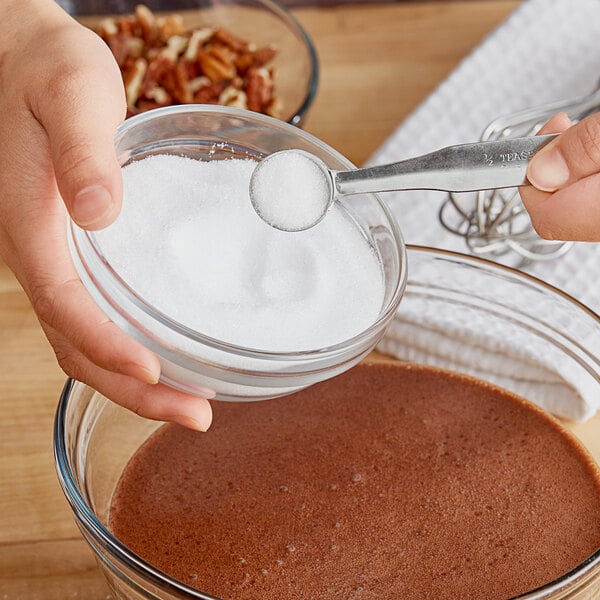
Erythritol is a sugar alcohol naturally found in fruits like pears and grapes but is typically produced commercially through a fermentation process using glucose. Erythritol is about 70% as sweet as sugar, making it a suitable option for those looking to reduce their sugar intake without sacrificing sweetness in their recipes. One of the advantages of erythritol is its low-calorie content. With only 0.2 calories per gram, erythritol is an attractive option for individuals seeking to manage their caloric intake. Additionally, erythritol does not raise blood sugar levels or insulin levels, making it a safe choice for those with diabetes or those following a low-carb or ketogenic diet.
In commercial applications, erythritol is commonly used in a variety of products like baked goods, beverages, and confectionery items. Its ability to mimic the taste and texture of sugar makes it a versatile ingredient for manufacturers looking to create healthier alternatives to traditional sugary products. Erythritol is also heat-stable, making it suitable for baking and cooking at high temperatures without compromising its sweetness or structure. Erythritol has a cooling effect when consumed, which can enhance the overall sensory experience of products like chewing gum and mints. This unique characteristic sets erythritol apart from other sugar substitutes and can be leveraged by food and beverage companies to create innovative and appealing products for consumers seeking healthier options. Here are some tips for substituting erythritol for sugar:
- Use in Crispy Recipes: Erythritol can give baked goods a crispy finish, so use it in recipes where this is desired.
- Add Extra: When substituting erythritol for sugar, you will need 30% more erythritol since it is only 70% as sweet.
- Prevent Crystallization: Never use more than 1/2 cup of erythritol per recipe to prevent crystallization.
- Put in Same Day Foods: After a day, erythritol produces a cooling effect. If this isn't desired, put it in recipes that will be consumed that same day.
Allulose
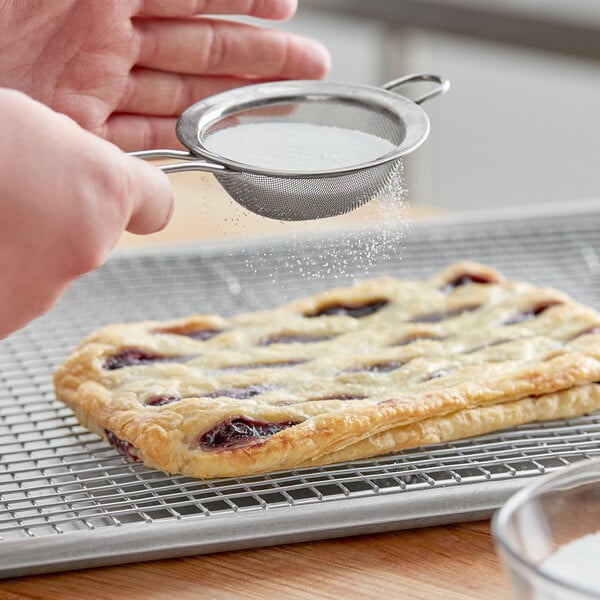
Allulose, also known as D-psicose, is a monosaccharide sugar naturally found in fruits like figs and raisins in small quantities. However, it is mainly produced through the enzymatic conversion of fructose from corn. While traditional sugars contain about 4 calories per gram, allulose only provides around 0.4 calories per gram. This makes it an attractive option for manufacturers looking to reduce the calorie content of their products without sacrificing sweetness. Furthermore, allulose has a clean, neutral flavor profile with no bitter aftertaste. Just like traditional sugars, it contributes to the browning and caramelization effects in baked goods.
Another advantage of allulose is its ability to mimic the taste and texture of sugar without causing a significant impact on blood sugar levels. Allulose is not metabolized by the body in the same way as glucose, so it does not raise blood glucose or insulin levels significantly. In addition to its low-calorie and low-glycemic properties, allulose also has a similar sweetness profile to sugar. It is about 70% as sweet as sucrose, making it a viable substitute in a wide range of applications, from baked goods to beverages. Allulose is heat-stable, meaning it can be used in cooking and baking without losing its sweetening properties. Here are tips for substituting allulose for sugar:
- Add Extra: You will need 30% more allulose since it is only 70% as sweet as sugar.
- Alter Bake Times and Temperatures: Allulose will brown faster than sugar and caramelize at a lower temperature. You will need to bake at lower temperatures for longer, we recommend keeping the heat under 300 degrees Fahrenheit.
- Gelling Quality: If you add allulose to wet ingredients and then heat it, it will melt quickly. It will create a jelly-like texture once cooked and cooled that is creamy and perfect for making caramels, syrups, and pastry cream.
- Retains Moisture: A benefit of allulose is it helps baked goods retain moisture, so it is ideal for recipes you want to be soft and tender. However, it won't harden after you bake with it, so you might have to freeze or chill baked goods to cause them to firm up.
- Won't Crystalize: Unlike sugar, allulose doesn't crystalize.
Types of Liquid Sweeteners
Liquid sweeteners are a great alternative to solid sweeteners. From drinks to baked goods to toppings, liquid sweeteners can be used in a variety of applications.
Flavored Syrup
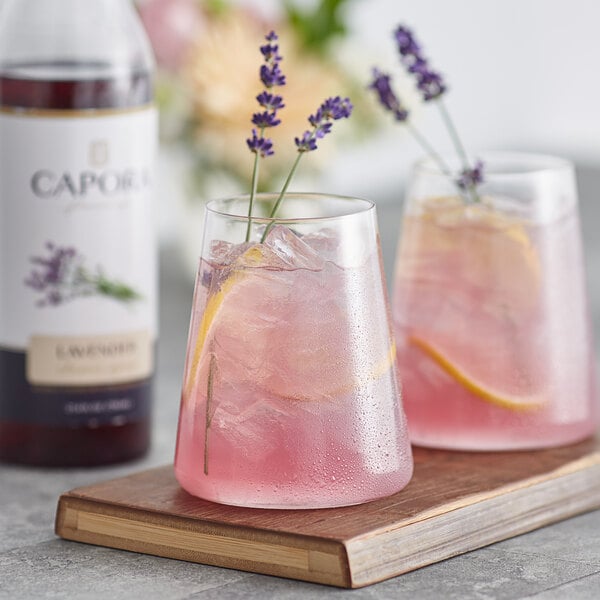
Flavored syrup is a versatile ingredient commonly used in commercial food and beverage establishments to add sweetness, flavor, and complexity to a wide range of dishes and drinks. This type of syrup is typically made by combining a sweetening agent, such as sugar or corn syrup, with natural or artificial flavorings to create a concentrated liquid with a distinct taste profile. Flavored syrups come in a variety of flavors, ranging from classic options like vanilla, caramel, and chocolate to more exotic choices such as lavender, ginger, and passion fruit. These syrups can be used to enhance the taste of beverages like coffee, tea, cocktails, smoothies, desserts, baked goods, and savory dishes.
One of the key benefits of using flavored syrup in commercial settings is the convenience it offers. These syrups are ready-to-use and require no additional preparation, making them a time-saving solution for busy kitchens and bars. Flavored syrups also enhance coffee drinks and provide consistent flavor profiles, ensuring that each drink maintains a high level of quality and taste. Flavored syrups are also highly customizable, allowing chefs and bartenders to experiment with different flavor combinations to create unique and innovative menu items. Whether used as a sweetener, a flavor enhancer, or a decorative element, flavored syrups can elevate the overall dining experience for customers and help establishments stand out in a competitive market.
- Flavor: Varieties include fruit, floral, herbal, nut, spice, chocolate, and caramel
- Applications: Bakery, pastry, and savory applications, as well as for use in beverages
Honey
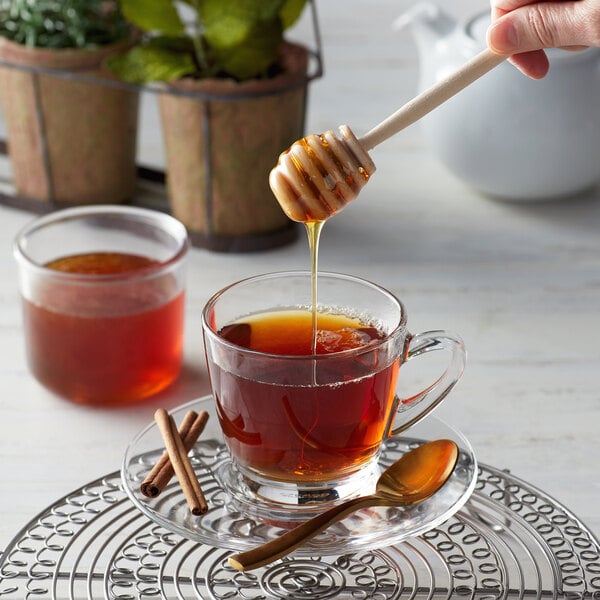
Produced by honey bees from the nectar of flowers, honey is a versatile ingredient that offers a unique flavor profile and a range of health benefits. It primarily consists of sugars such as glucose and fructose which give honey its sweet taste. It also contains vitamins, minerals, and antioxidants, making it a more nutrient-dense option than refined sugars. When selecting honey for commercial use, it is important to consider factors such as flavor profile, color, and viscosity to ensure it complements the desired application. The color and flavor of honey varies depending on the types of flowers visited by the bees during nectar collection. Some popular types of honey include clover, wildflower, and orange blossom honey.
Honey can be found in different forms, including comb honey, chunk-style honey, liquid honey, and whipped honey. Comb honey is honey that is still in its original beeswax comb, providing a pure and unprocessed form of honey. Chunk-style honey contains pieces of honeycomb mixed with liquid honey, offering a textured and flavorful option. Liquid honey is the most common form of honey, as it is easy to use and pour, making it a versatile choice for various applications. Whipped honey, also known as creamed honey, is a smooth and spreadable form of honey that has been processed to create a creamy consistency. Whether used in baked goods, beverages, or savory dishes, honey adds a unique sweetness and complexity that can enhance the overall flavor profile of a dish.
- Flavor: Sweet with fruity, woody, nutty, floral, spicy, or earthy essences depending on its nectar source
- Applications: Baked goods, sweetening beverages, compound butter, marinades, sauces
Maple Syrup
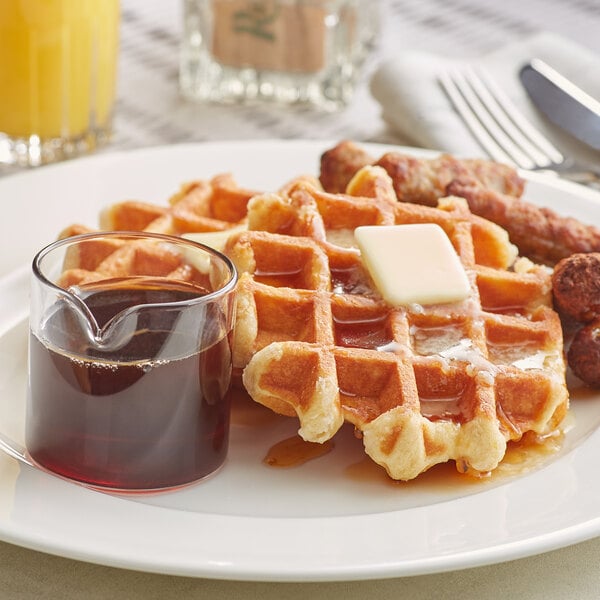
Maple syrup is a natural sweetener derived from the sap of sugar maple trees. This liquid gold has been enjoyed for centuries and is a popular choice for adding sweetness to a variety of dishes and beverages. To produce maple syrup, sugar maple trees are tapped in late winter or early spring when the sap begins to flow. The sap is collected in buckets or through a tubing system, and then boiled down to evaporate the water content, leaving behind the concentrated syrup. It takes about 40 gallons of sap to produce just one gallon of maple syrup, highlighting the labor-intensive process involved in its production.
Maple syrup is graded based on color and flavor, with different grades suited for various culinary applications. Grade A maple syrup is further categorized into Light Amber, Medium Amber, Dark Amber, and Very Dark, each offering a distinct taste profile ranging from delicate and mild to robust and full-bodied. Not only is maple syrup a delicious sweetener, but it also contains essential nutrients such as manganese, riboflavin, zinc, and calcium. It is a healthier alternative to refined sugars and artificial sweeteners, making it a popular choice for health-conscious consumers. Whether drizzled over pancakes and waffles, used in baking recipes, or incorporated into marinades and dressings, maple syrup adds a rich, complex sweetness that enhances the flavor of a wide range of dishes. Its versatility and unique flavor profile make it a staple in commercial kitchens and food establishments looking to elevate their culinary offerings.
- Flavor: Sweet and rich with notes of caramel and vanilla
- Applications: Accompanying pancakes, waffles, and French toast, as well as for use in bakery, pastry, confections, and savory applications
Molasses
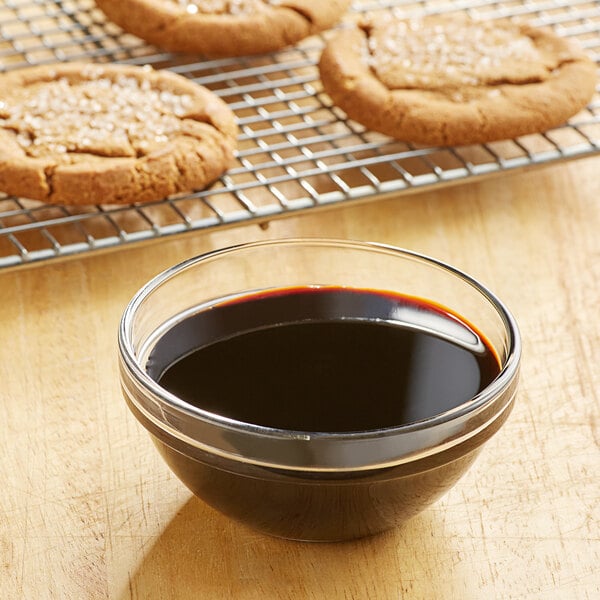
Molasses, a byproduct of sugar production, is a dark, viscous liquid with a robust and complex flavor profile. Its taste is characterized by rich notes of caramel and toffee punctuated by a hint of bitterness. Molasses offers a deep sweetness that can enhance the depth of flavor in baked goods, savory dishes, and beverages. Its distinct flavor makes it a popular choice for adding depth and complexity to various recipes. As a natural sweetener, molasses contains essential nutrients such as iron, calcium, magnesium, and potassium, making it a healthier alternative to refined sugar.
There are several types of molasses available, each with its own distinct flavor profile and uses. Light molasses, also known as mild molasses, has a lighter color and a milder flavor compared to other types of molasses. It's commonly used in baking, marinades, and glazes. Dark molasses has a more robust flavor and a darker color due to its higher concentration of sugar. It's often used in gingerbread, baked beans, and barbecue sauce for its bold and rich taste. Blackstrap molasses is the most concentrated and least sweet type of molasses known for its intense flavor and high mineral content. It's often used in savory dishes, such as stews and sauces, as well as in baked goods for a deep, caramel-like taste.
- Flavor: Caramel, toffee, and a hint of bitterness
- Applications: Gingerbread, BBQ sauce, candy making
Agave Nectar Syrup
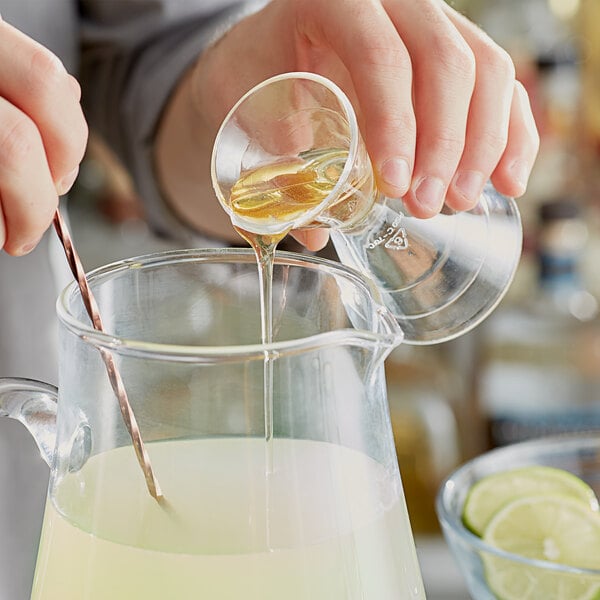
Agave nectar syrup is a natural sweetener derived from the agave plant, primarily found in Mexico. Agave syrup is known for its distinct flavor, often described as sweeter than sugar with subtle honey essences. This makes it a popular choice for adding sweetness to beverages, baked goods, and other culinary creations. The four main types of agave nectar are light, amber, dark, and raw. Each type offers a unique flavor profile and color intensity, making them versatile options for commercial applications in food and beverage preparation.
Agave is known for its low glycemic index, making it a popular choice for those looking to manage their blood sugar levels. The fructose content in agave nectar typically ranges from 70% to 90%, depending on the processing method and variety of agave plants used. This high fructose content gives agave nectar its intense sweetness. It is 1.5 times sweeter than sugar and 50% sweeter than honey. Subsequently, using agave can save restaurants money because they can sweeten their dishes with less product. With a thinner consistency than honey, agave nectar syrup is easy to mix into beverages and baked goods, making it a versatile option for commercial kitchens.
- Flavor: Intensely sweet with a honey essence
- Applications: Sugar/honey substitute, sweetened beverages, as a breakfast syrup
Corn Syrup
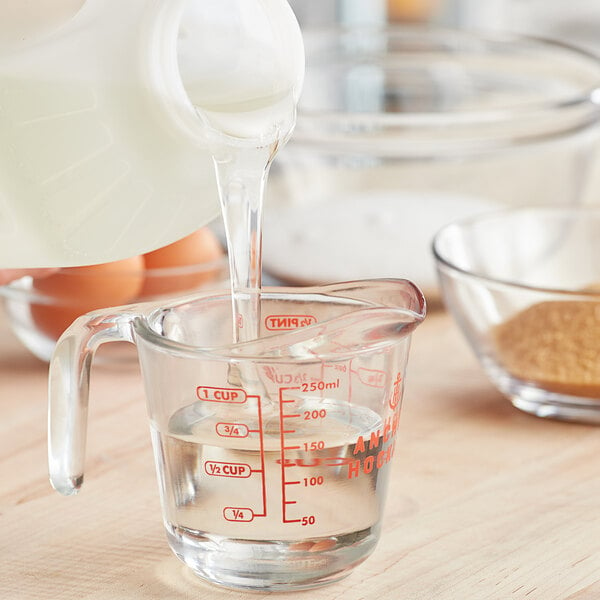
Corn syrup is a versatile sweetener commonly used in commercial food production due to its unique properties and applications. It is a liquid sweetener made from cornstarch through a process that breaks down the starch into simpler sugars. It's less sweet than granulated sugar, making it a popular choice when a milder sweetness is desired. Corn syrup is hygroscopic, meaning it attracts and retains moisture. This property helps to prevent crystallization in candies and frostings, resulting in a smooth and glossy texture. Corn syrup also acts as a humectant, extending the shelf life of products by maintaining their moisture content.
Corn syrup is available in two main forms: light corn syrup and dark corn syrup. Light corn syrup is clear and sweet, with a milder flavor compared to dark corn syrup. It is primarily used in recipes where a sweetener is needed without adding color or a strong flavor. Light corn syrup is often used in baking, candy making, and as a sweetener in beverages. Dark corn syrup has a deeper color and flavor due to the addition of molasses or caramel color. It is commonly used in recipes for pecan pies or dark-colored sauces. Dark corn syrup also helps to retain moisture in baked goods, making them softer and more tender.
- Flavor: mild sweetness with either vanilla or caramel essences depending on whether it is light or dark corn syrup
- Applications: Baked goods, frostings, and candies
Related Resources

January 2025 WebstaurantStore Coupon Code
The holiday season is over, and to ring in the new year and combat the post-holiday blues, you can find amazing deals on important items here at WebstaurantStore all January long! From essential coffee service equipment to ingredients and supplies for your favorite winter recipes, we have a slew of great deals to warm you up this cold season! Check out our selection of sale items below and don't forget to enter the code FROSTY26 at checkout to enjoy 10% off your purchases! Looking to save even more? Check out the new Webstaurant Rewards® Visa Business Card ! Sign up for a new card today and start earning rewards on every WebstaurantStore purchase, and save on a WebstaurantPlus subscription. Explore incredible deals on winter disposable item

What Is Caster Sugar?
Caster sugar is granulated sugar with a very fine consistency. Also called castor sugar or superfine sugar, caster sugar contains grains that are finer than table sugar, but not as fine as confectioners sugar. The texture of caster sugar makes it the best type of sugar for making certain desserts, baked goods, and cocktails. Whether you're starting a new bakery or are a seasoned baker, we'll help you learn answers to questions like "is caster sugar the same as powdered sugar?" and teach you how to make castor sugar out of ingredients you already have in your pantry. Shop All Sweeteners What Is Caster Sugar in the US? Caster sugar in America is often called superfine sugar, baker's sugar, castor sugar, or bar sugar. It is a term used in the
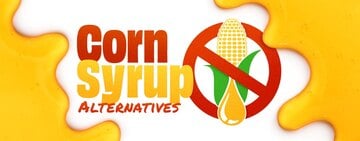
Substitutes for Corn Syrup
If you're trying to avoid using corn syrup, or maybe just need to substitute it for something you have on hand, then you're in luck! We've listed eight excellent substitutes for corn syrup below. Before diving in, know that some of these alternatives do not have the same chemical makeup as corn syrup. Corn syrup is used in recipes to prevent crystallization for a softer texture, making it perfect for candy making , and it can also give shine and volume to recipes like caramel and chocolate sauces or ice creams and brownies. A few of these alternatives cannot be used for candy making, so take the time to read about each one before using it. Corn Syrup Substitute When substituting corn syrup, know that corn syrup's sweetness level is around 7

